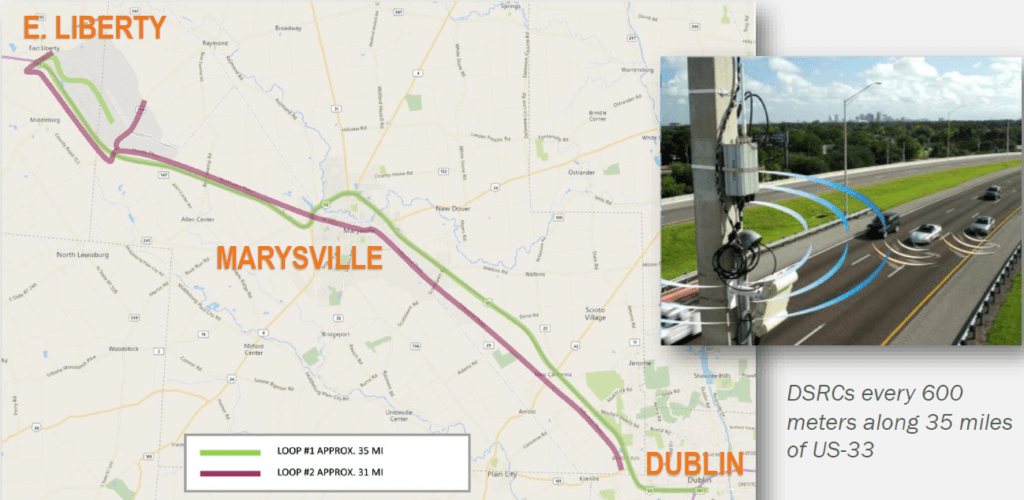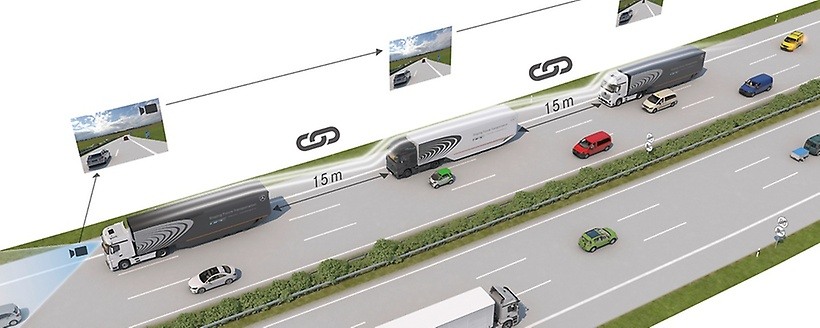Ohio’s Big Bet on the Future of Transportation

We typically think of governments as bumbling behemoths that are oftentimes more reactive than proactive when it comes to adopting new technologies. Not so in the case of the Buckeye State…
Ohio has embraced the digitalization of transportation by investing $15 million to make a 35-mile stretch of U.S. Highway 33 into “a real-world proving ground for autonomous and connected vehicles.” [1] The resulting Smart Mobility Corridor will have high-capacity fiber optic cable and wireless sensors embedded directly along the roadway, allowing researchers to monitor, collect, and analyze data on important variables such as weather, surface conditions, traffic, and accidents. The Corridor’s rich data stream will be a boon for companies such as Otto, a subsidiary of Uber, which retrofits long-haul trucks with self-driving technology. [2]
“Data collected on this corridor will allow automotive innovators to test and refine jobs‑creating technologies that are going to help move people and products more safely and efficiently,” said Ohio Department of Transportation (ODOT) Director Jerry Wray. “By being one of the first states to embrace autonomous and connected vehicle technology, Ohio can also be among the first to benefit from its rewards, giving Ohioans a safer, better driving experience and offering businesses reduced transportation costs, faster access to markets and increased efficiencies.” [1]

Autonomous vehicles typically refer to automated vehicles that do not require a human to operate. Connected vehicles are those that have the ability to communicate with the driver, other vehicles and with infrastructure. It is the potential to test vehicle to infrastructure (V2I) communications that makes the Smart Mobility Corridor a particularly exciting project. For example, the Corridor would be able to broadcast upcoming lane closures or unsafe conditions to the operating system of a driver-less connected vehicle, which in turn would adjust its speed and trajectory. [3] Connected vehicles would also be able to leverage V2I communications to more effectively “platoon” one behind another (i.e. a group of vehicles that travels very closely together and safely at high speed). [4] According to a 2013 paper published by the McKinsey Global Institute, “the benefits [of autonomous driving] provided by improved safety, time savings, productivity increases, and lower fuel consumption and emissions could have a total economic impact of $200 billion to $1.9 trillion per year by 2025.” [5]

While the Corridor’s full array of fiber optic cables and transmitters are not expected to be in place until late 2018, the project is part of a much larger and longer-term Smart Mobility Initiative that seeks to turn Ohio into a national transportation infrastructure leader. In addition to the Corridor, the state plans to fund two additional smart highway projects (I-270 and I-90) to help create a contiguous interstate testing ground for companies innovating in transportation. Supplementing these direct infrastructure investments is $45 million for research at the 4,500-acre Transportation Research Center (TRC) in East Liberty, which is one of the most advanced independent testing facilities for autonomous vehicle and smart highway research, including compliance and certification testing for vehicles and components, crash testing, emissions testing, and durability testing. Lastly, Columbus won a $40 million federal grant in 2016, along with $100 million of third-party co-investment, to develop Ohio’s capital city as a hub for intelligent transportation. [6]
While the long-term future looks bright for Ohio, the state must grapple with some pressing challenges. First is the issue of developing universal standards for wireless communications between vehicles and sensors on highway infrastructure. According to David Williams, dean of the OSU College of Engineering and a board member of the TRC, “at this moment, policy and standards and regulations are far behind [smart mobility technology]. So far, we’re just touching the tip of the iceberg with what needs to be studied…and whether the standards need to be national or global. These issues need to be managed pretty quickly.” [7] Second, with an estimated 3.5 million truck drivers in the U.S. and 68,500 in Ohio alone, the digitalization of transportation presents new challenges for a once stable blue-collar profession. [8][9] In the short and medium-term, Ohio will be prudent to develop a set of standards around autonomous vehicles and V2I communications that not only best serves the interests of the state and its citizens, but is also scalable to other regions in the U.S. Moreover, the government must carefully balance the interests of all stakeholders when it comes to drafting commercial policy around the operation of autonomous and connected vehicles on public roadways. If it is able to tackle these two matters successfully, the State of Ohio will become a shining example for other U.S. state governments to follow, and perhaps for global policymakers as well.
What is the best way to develop communications standards and regulatory policy for autonomous vehicles? Will the rise of autonomous vehicles and smart transportation infrastructure force long-haul truck drivers to find employment elsewhere, or can these workers adapt to fit new roles? Will political challenges be a gatekeeper to the technology becoming widely adapted in the U.S. and globally?
Word Count: 800
References:
[1] “Smart Mobility Corridor To Become Ohio’s First “Smart Road””. 2017. Dot.State.Oh.Us. https://www.dot.state.oh.us/news/Pages/SmartMobilityCorridor.aspx.
[2] Chain, The, and Roberto Michel. 2017. “The Evolution Of The Digital Supply Chain”. Logisticsmgmt.Com. http://www.logisticsmgmt.com/article/the_evolution_of_the_digital_supply_chain.
[3] “Northeast Ohio Accelerates Self-Driving Vehicle Effort: Here’s How It All Will Work”. 2017. Cleveland.Com. http://www.cleveland.com/metro/index.ssf/2017/01/northeast_ohio_accelerates_sel.html.
[4] Hall-Geisler, Kristen. 2017. “US Route 33 To Test V2I Tech”. Techcrunch. https://techcrunch.com/2017/06/07/us-route-33-to-test-v2i-tech/.
[5] Manyika, James, Michael Chui, Jacques Bughin, Richard Dobbs, Peter Bisson, and Alex Marrs. 2013. Disruptive Technologies: Advances That Will Transform Life, Business, And The Global Economy. Ebook. The McKinsey Global Institute. http://sites.gsu.edu/rcbvision2020/files/2015/08/disruptive-technologies-25x119j.pdf.
[6] “FY 18-19 Executive Budget – Smart Mobility”. 2017. Budget.Ohio.Gov. http://budget.ohio.gov/SmartMobility.aspx.
[7] Hamblen, Matt. 2017. “Columbus, Ohio, Region Boosts Smart Mobility Research”. Computerworld. https://www.computerworld.com/article/3171298/car-tech/columbus-ohio-region-boosts-smart-mobility-research.html.
[8] Sanctis, Matt. 2017. “Will AVs Mean Lost Jobs For The Trucking Industry?”. Govtech.Com. http://www.govtech.com/fs/transportation/Will-AVs-Mean-Lost-Jobs-for-the-Trucking-Industry.html.
[9] Solon, Olivia. 2017. “Self-Driving Trucks: What’s The Future For America’s 3.5 Million Truckers?”. The Guardian. https://www.theguardian.com/technology/2016/jun/17/self-driving-trucks-impact-on-drivers-jobs-us.
[Featured Image, Figure 1] “33 Smart Corridor: NW 33 Innovation Corridor – Council Of Governments”. 2017. Morpc.Org. https://www.morpc.org/Assets/MORPC/files/05-11-201733SmartCorridor.pdf.
[Figure 2] “Connected Trucks – Freight Transport Of The Future By Using The Internet | Daimler”. 2017. Daimler. https://www.daimler.com/innovation/digitalization/connectivity/connected-trucks.html.



In the long-term, autonomous trucks will push truck drivers to find employment elsewhere. However, it seems that we are still decades away from full autonomy and diffusion throughout the country, meaning that people may stop becoming truckers, but not an enormous number of truckers are likely to lose jobs as a result of the technology implementation. In the meantime, the rise in autonomous trucks will help the trucking industry as The American Trucking Association reports turnover as high as 90% for large truckload carriers and estimates a driver shortage of 50,000 by the end of 2017.[1]
[1] Aarian Marhsall “What Does Tesla’s Automated Truck Mean For Truckers,” Wired, Nov 17, 2017
Being a Michigan Wolverine, I am not a fan of the Buckeyes, but I do have to commend Ohio on its efforts regarding autonomous vehicles. Not only has it taken the lead in advancing this technology, and perhaps somewhat transforming its image into a more tech savvy state, but it has found a way to do so at a minimal cost, through partnerships and grants, and to position itself as the leader in this disruptive technology which in only a matter of time will become the norm. Ohio has made a play to become the hub of autonomous vehicle innovation, potentially leading to future job creation and investment into the state.
Ohio should not jump the gun on creating policies and regulation. This initiative has been set up as an experiment and the policies should be data driven. Similar to what many of us did for the Shad exercise, Ohio may need to reiterate its policies and regulations until it finds something that works and is scalable across states and countries.
Although I agree that truck driver are not at risk of loosing their job in the next year or two, autonomous vehicle technology is advancing and will likely be a real threat to job security within 5 years. However, what I question is how well this technology can work in cities and areas not covered by major highways. Will humans still be required to drive large trucks in and out of cities? If so, perhaps a group existing truck drivers can be reassigned to such roles. Without this sort of need, I do not expect truck drivers to have much of a role in our future economy.
As you mention there are several regulatory policies and standards that must be carefully formed to ensure a productive and safe autonomous vehicle ecosystem. An additional policy consideration is one of cybersecurity. The state and country will need to ensure that the vehicles are monitored safely and protected against hacking which poses a serious security threat we are not exposed to today. This can be particularly challenging if the industry looks to developing vehicle to vehicle information systems where cars provide information to one another. You can read more on this topic here (https://techcrunch.com/2016/08/25/the-biggest-threat-facing-connected-autonomous-vehicles-is-cybersecurity/). This issue supports the notion that autonomous driving regulations should indeed be establish on a national level.
The regulatory implications of autonomous vehicles are massive because they are tied to the insurance implications, which is something not mentioned in this essay but which warrants some thought.
Currently, in most states, there is a mandated level of insurance coverage. Having worked in the insurance field, I know that the regulatory impact of autonomous vehicles is top of mind. One reason for this is because, currently, decisions about driving safety and insurance requirements are left up to the state, and for good reason. Driving conditions, behaviors and norms all vary from state to state, so it makes sense to regulate at the state level. Insurance companies, in turn, organize around supporting these legal requirements. Should autonomous cars become more widespread, however, this may lead to a standardization of how roads need to be designed to accommodate these cars. And driving quality itself will obviously become more standardized. Does this mean regulation and insurance of drivers will no longer be in a state’s hands, and will become a Department of Transportation concern solely? What does this mean for insurance companies, how they service customers and the value they provide? This would have been a good topic to explore.